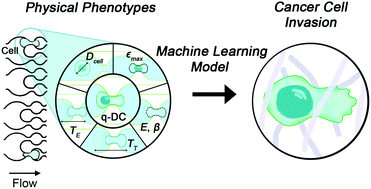Predicting cancer cell invasion by single-cell physical phenotyping†
Abstract
The physical properties of cells are promising biomarkers for cancer diagnosis and prognosis. Here we determine the physical phenotypes that best distinguish human cancer cell lines, and their relationship to cell invasion. We use the high throughput, single-cell microfluidic method, quantitative deformability cytometry (q-DC), to measure six physical phenotypes including elastic modulus, cell fluidity, transit time, entry time, cell size, and maximum strain at rates of 102 cells per second. By training a k-nearest neighbor machine learning algorithm, we demonstrate that multiparameter analysis of physical phenotypes enhances the accuracy of classifying cancer cell lines compared to single parameters alone. We also discover a set of four physical phenotypes that predict invasion; using these four parameters, we generate the physical phenotype model of invasion by training a multiple linear regression model with experimental data from a set of human ovarian cancer cells that overexpress a panel of tumor suppressor microRNAs. We validate the model by predicting invasion based on measured physical phenotypes of breast and ovarian human cancer cell lines that are subject to genetic or pharmacologic perturbations. Taken together, our results highlight how physical phenotypes of single cells provide a biomarker to predict the invasion of cancer cells.



 Please wait while we load your content...
Please wait while we load your content...